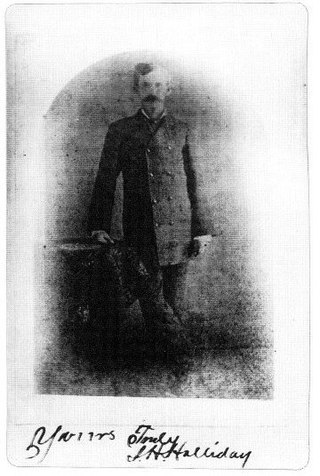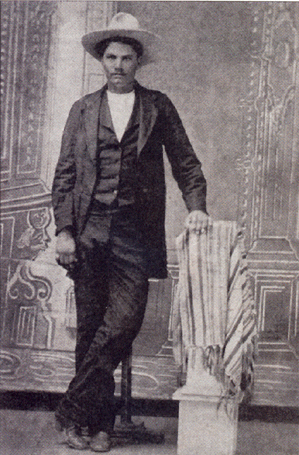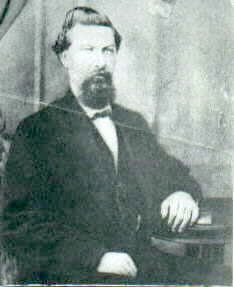
John HenryHolliday, better known as Doc Holliday, was a dentist and later a gambler, gunfighter, and a close friend and associate of lawman Wyatt Earp. Holliday is best known for his role in the events surrounding and his participation in the Gunfight at the O.K. Corral in Tombstone, Arizona. He developed a reputation as having killed more than a dozen men in various altercations, but modern researchers have concluded that, contrary to popular myth-making, Holliday killed only one to three men. Holliday's colorful life and character have been depicted in many books and portrayed by well-known actors in numerous movies and television series.

James Butler Hickok, better known as "Wild Bill" Hickok, was a folk hero of the American Old West known for his life on the frontier as a soldier, scout, lawman, cattle rustler, gunslinger, gambler, showman, and actor, and for his involvement in many famous gunfights. He earned a great deal of notoriety in his own time, much of it bolstered by the many outlandish and often fabricated tales he told about himself. Some contemporaneous reports of his exploits are known to be fictitious, but they remain the basis of much of his fame and reputation.

Virgil Walter Earp was both deputy U.S. Marshal and Tombstone, Arizona, City Marshal when he led his younger brothers Wyatt and Morgan, and Doc Holliday, in a confrontation with outlaw Cowboys at the Gunfight at the O.K. Corral on October 26, 1881. They killed brothers Tom and Frank McLaury and Billy Clanton. All three Earp brothers had been the target of repeated death threats made by the Cowboys who were upset by the Earps' interference in their illegal activities. All four lawmen were charged with murder by Ike Clanton, who had run from the gunfight. During a month-long preliminary hearing, Judge Wells Spicer exonerated the men, concluding they had been performing their duty.

John Wesley Hardin was an American Old West outlaw, gunfighter, and controversial folk icon. Hardin often got into trouble with the law from an early age. He killed his first man at the age of 15, claiming he did so in self-defense.

Gunfighters, also called gunslingers, or in the late 19th and early 20th century, gunmen were individuals in the American Old West who gained a reputation of being dangerous with a gun and participated in shootouts. Today, the term "gunslinger" is more or less used to denote someone who is quick on the draw with a handgun, but this can also refer to those armed with rifles and shotguns. The gunfighter is also one of the most popular characters in the Western genre and has appeared in associated films, television shows, video games, and literature.
"Big" Steve Long was an American law enforcement officer and outlaw, achieving notoriety in the Wyoming Territory during the late 1860s. He was one of the earliest examples of an Old West gunman. Because of their lawlessness, he and two half-brothers were lynched by a posse put together by newly appointed sheriff N.K. Boswell in 1868.

Fast draw, also known as quick draw, is the ability to quickly draw a handgun and accurately fire it upon a target in the process. This skill was made popular by romanticized depictions of gunslingers in the Western genre, which in turn were inspired by famous historical gunfights in the American Old West.

Timothy Isaiah Courtright, also known as "Longhair Jim" or "Big Jim" Courtright, was an American Deputy Sheriff in Fort Worth, Texas from 1876 to 1879. In 1887, he was killed in a shootout with gambler and gunfighter Luke Short. Before his death, people feared Courtright's reputation as a gunman, and he reduced Ft. Worth's murder rate by more than half, while reportedly extracting protection money from town business owners.

Luke Lamar Short was an American Old West gunfighter, cowboy, U.S. Army scout, dispatch rider, gambler, boxing promoter, and saloon owner. He survived numerous gunfights, the most famous of which were against Charlie Storms in Tombstone, Arizona Territory, and against Jim Courtright in Fort Worth, Texas. Short had business interests in three of the best-known saloons in the Old West: the Oriental in Tombstone, the Long Branch Saloon in Dodge City, and the White Elephant in Fort Worth.
David Rudabaugh was a cowboy, outlaw, and gunfighter in the American Old West. Modern writers often refer to him as "Dirty Dave" because of his alleged aversion to water, though no evidence has emerged to show that he was ever referred to as such in his own lifetime.
John Joshua Webb was a noted lawman turned gunfighter and outlaw of the American Old West.
The Gunfight at Hide Park, or the Newton Massacre, was the name given to an Old West gunfight that occurred on August 19, 1871, in Newton, Kansas, United States. While well publicized at the time, the shootout has received little historical attention despite resulting in a higher body count than the Gunfight at the O.K. Corral and the Four Dead in Five Seconds Gunfight of 1881. Unlike most other well-known gunfights of the Old West, it involved no notable or well-known gunfighters, nor did it propel any of its participants into any degree of fame. The story has transformed into legend due to reports that one of the participants, James Riley, walked away from the scene and was never seen again.
Kinch 'James' Riley was a young man from Kansas who, on August 19, 1871 was the deciding factor in a little-known but deadly gunfight, which became known as the Gunfight at Hide Park, that took place in Newton, Kansas. The gunfight, despite being lesser known than either the Gunfight at the O.K. Corral or the Four Dead in Five Seconds Gunfight, resulted in more dead.

Philio Houston "Phil" Coe, was a soldier, Old West gambler, and businessman from Texas. He became the business partner of gunfighter Ben Thompson in Abilene, Kansas, with whom opened the Bull's Head Saloon. He was killed by marshal Wild Bill Hickok in a street brawl.
Frank Loving, sometimes called "Cockeyed" Frank Loving, was an Old West gambler and gunman. He was involved in two well-publicized shootouts of the day.

The Long Branch Saloon gunfight, on April 5, 1879, was an altercation that took place between Frank Loving and Levi Richardson at the Long Branch Saloon in Dodge City, Kansas. Both men were gamblers who frequented the saloon.
Dan Tucker, better known as "Dangerous Dan" Tucker,, is a little-known Canadian-American lawman and gunfighter of the Old West.

Martin J. "Mart" Duggan was a gunfighter of the American Old West who, although mostly unknown today, was at the time one of the more feared men in the west. He is listed by author Robert K. DeArment, in his book "Deadly Dozen", as one of the most underrated gunmen of the Old West.
James H. Leavy was an Irish gunfighter in the Old West. He is remembered today by Western historians for participating in at least two instances of a quick draw duel. In his time, Leavy was one of the most notorious gunmen in the Old West known for challenging other gunmen to a duel. He is featured in the book Deadly Dozen, written by author Robert K. DeArment as one of the twelve most underrated gunmen of the 19th century West.
Hugh Anderson was a cowboy and gunfighter who participated in the infamous Gunfight at Hide Park on August 19, 1871, in Newton, Kansas. Prior to the gunfight, Anderson was a son of a wealthy Bell County, Texas cattle rancher who drove from Salado, Texas, to Newton. Anderson was the one who led the cowboy faction during the gunfight, and was also one of the first to draw blood.










